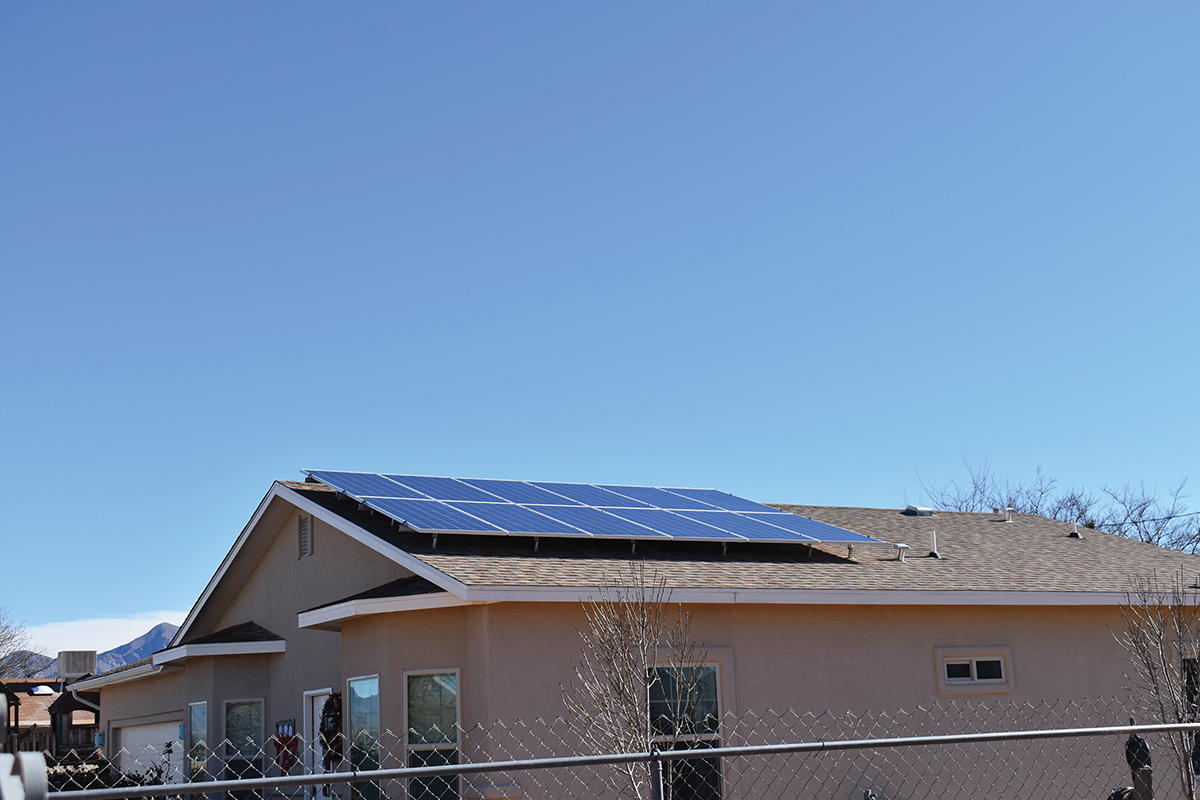Code-making panel (CMP) 18 has oversight for Articles 393 for ceiling systems, 406 for receptacles, 410 for luminaires, 411 for low voltage lighting, 600 for signs, and 605 for office furnishings. Let’s cover the more significant changes within these particular articles but will not cover all of the changes. It is always important to read the 2023 NEC for the exact language which has been changed, modified, or eliminated.
NEC 406.3(D)(3)
There is new text added in NEC 406.3(D)(3) is intended to emphasize the limitation to maximum 15-ampere circuits, and 14 AWG solid type copper conductors are only allowed to be utilized with the “push-in” type terminals for receptacles. The public input for this revision was submitted by a Task Group formed in accordance with the direction of the NFPA Standards Council. This Public Input and other Public Inputs submitted to other code-making panels are related to new requirements covering the use of copper-clad aluminum conductors throughout the NEC. They are intended to coordinate new or revised requirements. Underwriters Laboratories (UL) Standard UL 498 and associated guide information under UL category code “RTRT” for receptacles with push-in terminals, which only permits only 14 AWG solid copper conductors and is limited to 15-ampere branch circuits as of this point in time. These push-in terminals are the screwless terminal connectors located on the back side of receptacles. These push-in type terminals are not intended for use with aluminum or copper-clad aluminum wire, 14 AWG-stranded copper wire, or 12 AWG solid or stranded copper wire. The introduction of 14 AWG copper-clad aluminum into the NEC for branch circuit wiring needs this requirement to ensure that push-in terminals on wiring devices are installed per their listing. An option was added within this section to provide a future allowance for other conductor types (i.e., “stranded 14 AWG copper or even 14 AWG copper-clad aluminum) to be installed using push-in type terminals where the additional evaluation to the applicable UL 498 standard has been completed and the listing and device markings
NEC 406.4(D)(3)
Section 406.4(D)(3) is a new requirement that will require ground fault circuit interrupter (GFCI) receptacles to be listed. The submitter of this Public Input brought up that the NEC requires that AFCIs be listed, but no such requirement was in the NEC for GFCI devices. The Panel agreed with the submitter that an important safety device such as a GFCI receptacle should also be required to be tested and certified by an independent third-party laboratory, such as UL, ELT, CSA, or other similar OSHA recognized testing labs. GFCI devices are every bit as important, perhaps even more so than the AFCI devices specified in 210.12 and 406.4(D)(4), which are presently required to be listed. Using unlisted GFCI devices should not be permitted due to the fact these safety devices are simply too important to allow anything less. By adding this requirement, the public will be assured all GFCIs are listed and thereby manufactured per the minimum standards set forth in UL 943. CMP-18 also removed the term “outlet” to improve and clarify the intent of the current Code language. Also, abbreviations in 406.4(D)(4) of “AFCI” were incorporated to improve consistency with like terms. The specific type (i.e., receptacle, breaker) was retained for clarity. This change is also in accordance with the 2020 NEC Style Manual.
NEC 406.4(D)(8)
NEC 406.4(D)(8) is a new requirement in the 2023 NEC. It now requires ground fault protection of equipment (GFPE) to be provided for replacement receptacles which are required to be GFPE by present Code requirements elsewhere within the NEC, such as for receptacles that provide shore power to boats are required to have individual ground-fault protection of equipment (GFPE) per Section 555.35(A)(1). This new requirement for GFPE is very similar to Section 406.4(D)(3), which requires ground-fault circuit interrupter (GFCI) protection to be provided if a receptacle is replaced where the NEC presently requires GFCI protection. It’s also similar to Section 406.(D)(4) for arc-fault circuit interpreter protection (AFCI) for circuits that require this protection in accordance with Section 210.12. Providing the ground-fault protection of equipment protection (GFPE) when modifications are made in areas such as marinas where GFPE protection has been recently expanded will add protection to the electrical systems as these systems age and modifications are made. This new requirement will protect the people who use this electrical equipment and provide a safer electrical system. GFCI protection provides personnel protection at the 4-6 ma level, where GFPE protection provides protection at a 30 ma trip level.
NEC 406.4(D)
The change to NEC 406.4(D) adds language which limits the load for the faceplate to one watt or less and specifically requires the screws on the receptacles to be made only of brass or copper alloy. These faceplate provide an LED function or USB option that is incorporated into the faceplate. The original Public Input requested the faceplate be connected utilizing an approved wiring method or, if connected with friction or spring contacts to the receptacle side screws, that this connection is evaluated and approved by the receptacle Manufacturer. During the Public Comment development stage, there were Public Comments received that opposed the text added after the first draft meetings. The Public Comments included reasons the first Draft text should not be accepted, including that one Manufacturer should not be regulating or controlling the use of another product. The other substantiation submitted was there were no reported instances where these faceplates had caused any issues and that spring-tensioned contacts have an excellent safety record based upon over 4 million of these National Recognized Testing Laboratories (NRTL) Listed faceplate products already being installed.
Public Comments also indicated that there are good designs with a good record in the field by using proper materials and accommodating the various receptacles in the field. After much discussion on the original Public Input and follow-up Public Comments, the code panel changed course. It will continue to allow the listed receptacle faceplates without additional oversight by the manufacturers. The code panel did add in the requirement that the screws be constructed of brass or copper alloy after concerns with steel screws and the uncertainty of their reliability over the long term for this type of connection. An exception was added to have an effective date of January 1, 2026, to allow spring tension contacts if the receptacle faceplate is specifically listed and identified for connecting to steel screws on receptacles. The implementation date for the exception is to provide time to evaluate a possible conflict with UL 498 regarding the use of steel screws to carry current and time to develop safety requirements in UL 514D for faceplate connection methods.
NEC 406.9(C)
Section 406.9(C) Receptacle’s location has been clarified for restrictions in and around bathtubs and showers. A new Exception #4 was added to allow single receptacles within 36” of the tub or shower with limitations. CMP-18 accepted this change because the area below the bathtub rim was not included in the language inserted into the 2020 NEC. The areas outside and below the rim of a bathtub are just as important as those above the rim extending out three feet. The expansion of restricting where receptacles could be installed around bathtubs and showers did not previously include that area below the rim of a bathtub or shower. Bathtub rims are typically located 16″ above the floor; this area from the floor of the room and to the height of the rim is just as important as the area above the 16″ rim of the bathtub extending out 36”.
New Exception #4 was added to accommodate the toilets with electronic seats, bidets, and other functions, which require 120-volt receptacles to be installed within the 36” zone or personal hygiene devices for people with physical limitations. This receptacle shall require a single receptacle and cannot be located in the space between the bathtub or shower and the toilet or bidet; in other words, the new exception will be that the receptacle shall be located on the opposite side of the toilet or bidet from the tub or shower location. The single receptacle in this location would also need to be GFCI protected and located in a readily accessible location. The Plumbing Manufacturers International (PMI) submitted a Tentative Interim Amendment (TIA) during the summer of 2021 for this allowance for the 2020 NEC. TIA # 1598 was accepted and approved; this exception is presently allowed with the 2020 NEC. There were concerns that some consumers with physical limitations needed the devices for health and safety reasons, and without this exception, it provides an undue burden on these consumers.
NEC 406.12
There were some editorial changes to allow an easier understanding of where tamper-resistant receptacles are required; additional areas and occupancies were also added where tamper-resistant receptacles will now be required in NEC 406.12. The text in 406.12(5) for clinics, medical, dental offices, and outpatient facilities was revised and put into a list format to clarify the areas where tamper-resistant receptacles are intended to be installed. Basically, tamper-resistant receptacles are needed where children may be occupying specific spaces within clinics, medical, and dental offices. These areas would include waiting rooms or areas and business offices accessible to the public. Sleeping areas or rooms within Nursing Homes and Limited Care Facilities were added due to the concern that these occupants need additional safety mechanisms within the receptacles due to age or other circumstances and conditions.
The 2023 NEC 406.12(10) was created to expand the areas tamper-resistant receptacles will now be required within agricultural settings. Tamper-resistant receptacles will be required in more areas where children and the general public will be present in those agricultural buildings and common areas. The submitter of this change indicated where there are petting zoo’s on farms, pumpkin patches where they offer other items for sale within buildings on the farm, apple orchards, and similar type agricultural settings where children are present, the additional safety of tramper resistant receptacles were needed. There was a New Informational note #3 added to clarify the areas intended on applying within agricultural areas, such as petting areas, sales areas for the general public to visit, and other similar areas.
NEC 410.10(F)
Section 410.10(F) will now require a minimum of 1 ½” to luminaires under any roof system where physical damage can occur to the luminaire. This requirement will no longer only apply to only to metal corrugated style roof systems. There are many types of roof systems, in addition to metal corrugated roof systems, such as rubber roofing or shingle type roofs where the roofing is installed and then replaced, and therefore is also subject to the damage of screws or nails. Roofers miss trusses or rafters when nailing/screwing roofing materials such as foam insulation, roof coverings, plywood, or OSB sheeting and could puncture luminaires. The qualifier “where subject to physical damage” is added to any condition that would protect the luminaire installation from damage due to roof fasteners, including concrete slabs. The Panel members had many discussions on the expansion of this requirement and found that members agreed all types of roofs have the same potential for all wiring methods to be damaged. There was a Public Input which suggested an exception be added where the metal corrugated roof was covered with a minimum 2″ concrete slab; this type of construction could still have longer fasteners installed and penetrate through a luminaire. Therefore, after much discussion, the code panel decided to address all types of roof systems, as this damage is an issue with all types of roof systems. This will provide some added protection for luminaire from being damaged from penetrating fasteners from the roof system above.
NEC 410.71
The requirement for disconnects for luminaires has been relocated to Part VI of Article 410 [410.130(G)] from Part XII of Article 410 (New 410.71) due to the fact that LED drivers were added into this section of Article 410. The original requirement for disconnects into 410.130(G) was added into the 2005 edition of the NEC in response to an accident involving a double-ended lamp fluorescent ballast replacement. During that code cycle, luminaire installations and repairs primarily consisted of doubled-end lamps requiring a ballast. Since that time, lighting systems have evolved, and fluorescent lamps are being discontinued and replaced with LED lamps. Many of the existing fluorescent luminaires are being upgraded to incorporate LED lamps to meet energy conservation requirements. The additional requirement for LED luminaires was added to address a hazard that would exist with either style of a luminaire. Expanding the requirement only addresses LED-type luminaires that are equivalent to fluorescent luminaires that utilize double-ended lamps.
The submitter indicated that many of the LED luminaires are being installed as a part of a retrofit, changing the driver out, or hardwiring the end sockets while the circuit feeding the luminaire is energized is a regular practice. Furthermore, for many reasons, maintenance individuals and electricians do not disconnect the power while servicing. In some cases, the circuit may not be properly identified; when the circuit is de-energized, the room becomes dark, or the circuit may feed a large area and create interruptions. Work practices alone will not change the electrical safety culture. The submitter indicated that safety standards such as the NEC must provide equipment requirements that safeguard individuals exposed to the hazards of electricity while maintaining that equipment. The code panel discussed and decided this would enhance the safety of the installation where the LED luminaires were using double-ended lamps, which are similar to the fluorescent luminaires.
NEC 600.5(A) Exception
A new Exception #1 was added to Sections 600.5(A) and(B). This text was originally in the last sentence of the main body of requirement [600.5(A)]. The text in new Exception #1 was previously located as the last sentence in the main body of 600.5(A) in the 2020 NEC. The new Exception does not change any requirements from the 2020 to the 2023 NEC; this exception does not require sign circuits to be located at entrances used for deliveries or exclusively by the employees. The sign branch circuit is required for entrances at each commercial occupancy accessible to pedestrians; this generally applies to the entrances used for the customers or the general public. The submitter of this Public Input pointed out this was written as an exception to the rule and, as such, belonged in an exception and not in the main body of the Code section. CMP-18 agreed with the submitter and relocated the text in the last sentence to a new Exception. Exception No. 2 was added; this allows time clocks and similar devices to be on the same branch circuit as supplies the sign.
Exception No. 2 was added to clarify the additional equipment required to power the sign circuit and may be included in the rating of the branch circuit. Signs are often controlled by time switches or photocontrols, both of which would be considered “loads.” Even photocontrols use a small amount of power, typically less than 1 volt-amp. The proposed second exception permits the required branch circuit to also serve as the supply for a time switch or photocontrol directly related to the control of the sign.
NEC 600.35
Section 600.35 had redundant requirements removed, which were already covered in Chapters 1-4 of NEC. The Public Input had requested the entire 600.35 be removed; the submitter indicated that this material was redundant and not needed. The submitter indicated NEC 600.3, 110.3(B), 110.8, 110.12, and 600.4(B) did not need to be repeated in this Code section. A Public Comment was then received during the comment portion of the code change process and again requested 600.35 be removed in its entirety. List item (3) of 600.35(B) was removed by CMP 18 to comply with 4.1.1 of the NEC Style Manual, which does not allow requirements in chapters one through four not to be repeated in other Articles of the NEC. The result was 600.35 for retrofit kits would remain, although some redundant requirements were removed and in conflict with the NEC Style Manual section 4.1.1. Basic requirements such as the retrofit kit shall be listed and labeled, and parts within a sign not replaced by the retrofit kit, which is found to be damaged, must be replaced or repaired to maintain the sign or outline lighting system rating. There are different installation requirements for retrofit kits used in signs, and these kits are uniquely different than other retrofit kits and need to be addressed in this section.












Find Us on Socials